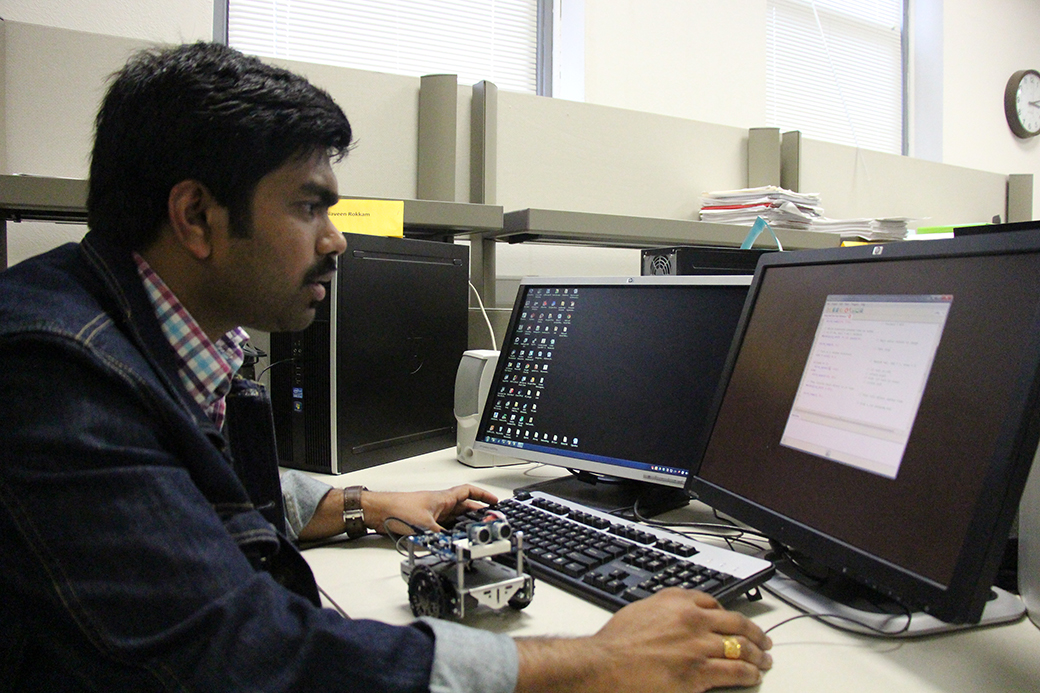
Computer science competition expands activities
A small, two-wheeled metallic robot scurries across the floor, its two sensors taking in information from its surroundings. The robot might look insignificant to the average observer, but for a select number of high school students it may offer a glimpse into a bright future.
The University of South Dakota Computer Science Department will host the 35th annual USD High School Robotics Programming Contest April 8.
Naveen Rokkam, a graduate student studying computer science, said the competition will consist of 36 teams from 20 high schools programming robots to navigate a maze in the Muenster University Center Ballroom. The high school students, who come from high schools in South Dakota, Iowa, Nebraska and Minnesota, have been working to build and program their robots for the last three months.
“They do some simple programming on how to make this robot run,” Rokkam said. “Each of the teams will run their robot on this maze and whoever makes it to the end of the maze in the fastest time will be the winner.”
Rokkam said this year is the first year that USD has had a robotics competition. In the past 34 years the competition has been a computer-based programming event that has attracted little attention.
“Generally they used to do a normal programming contest so we only used to have six teams participate,” Rokkam said. “Today we have 36 teams that have registered — and out of them I think almost everybody has been sent a $200 robot kit.”
Senior Mitchell Baye, a computer science major, said the Association of Computer Machinery (ACM) chapter at USD is helping to put on the competition. The organization designed the mazes and also chose the robots the students will be using.
“It looked like it (the chosen robot) was the most modular,” Baye said. “You can add your own stuff to it, like your own sensors.”
Baye said the students have been preprogramming their robots in the weeks leading up to the event, but they will also have a chance to adjust their programs at the beginning of the competition.
“Since it’s our first year we’re going a little bit easier on the schools,” Baye said. “We told them what the maze looked like beforehand so they’re able to preprogram the robots to transverse it and then they can make some adjustments right at the start.”
QuocNam Tran, the chair of the computer science department, said plans for the competition have been in the works for almost nine months. Tran said the purpose of the event is two fold.
“We want to attract more high school students to (the) computer science program here at USD,” he said. “We want to try to give (the students) some motivation for programming the robot instead of just bringing them and putting them in a lab to work on some boring programs.”
Tran said the grand prize for the winners of the competition will be reduced housing should they decide to attend college at USD. The $2,000-a-year prize is renewable for all four years at USD.
“In the past we gave the students small awards, something like $30 or $50. It’s not attractive at all in comparison with our competitors like Dakota State University and South Dakota State University,” Tran said. “That’s why this time we worked with the Office of Admissions and Marketing.”
Tran said the competition isn’t only helpful to high school students, but also to computer science college students who will be helping at the event.
“Our students here will be more familiar with robotic programming. Nowadays our production lines have been automated at a very high level,” Tran said. “If they know how to write efficient programs for robots, their chance for having a very good career opportunities could be increased significantly.”
Baye said he hopes the competition will inspire high school students to pursue computer science as a major.
“Hopefully they’ll be able to get a better understanding of programming in general and the computer science field. One of the first things when I was in high school that got me into computer science was robotics,” Baye said. “Having them do it through the school and letting them program on the side and see the enjoyment you can get after you see your finished product work correctly.”
(Photo: Naveen Rokkam, a graduate computer science student, programs a robot in the Arts and Sciences building April 6. The robot is the same type of robot that will be used in the 35th annual USD High School Robotics Programming Contest on April 8. Malachi Petersen / The Volante)

